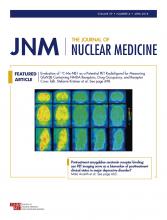REPLY: In response to the comments made by Chen et al. regarding our paper “Practical Immuno-PET Radiotracer Design Considerations for Human Immune Checkpoint Imaging” published recently in The Journal of Nuclear Medicine (1), we have taken the opportunity to discuss several important points.
Chen et al. begin by suggesting the development of murine versus human radiotracers for testing in syngeneic models. In fact, this is a valuable suggestion, and our laboratory often develops and validates complementary murine and human radiotracers in parallel. An active area of investigation is the development of cross-reactive binders (with affinity for both human and murine targets), to help further streamline biologic characterization and clinical translation processes. That said, the greater debate here surrounds the question of model selection. Model selection is critical to the development of imaging agents, and the appropriate model should be chosen given the goals and hypotheses of the study at hand. Although the verdict is still out on the value of mouse models in drug development, we often use syngeneic models when our primary question pertains to the biology of the model system. Here, we used a human xenograft tumor model to assess and characterize the ability of our engineered tracer to bind specifically to human programmed cell death ligand 1 (PD-L1). This decision was made because our primary goal was toward clinical translation. Because of the rapid pace of immunotherapeutic drug development, we believe the imaging community must act quickly to assess the feasibility and benefit of companion diagnostic tools in clinical trials alongside the therapeutics they are meant to complement. Chen et al. rightly point out that PD-L1 is expressed by various other cell types, including immune cells. Although they are correct that this signal will have to be taken into consideration when assessing immune checkpoint therapy, it is important to remember that PD-L1–targeted drugs will also bind to these sites. We believe systems-level expression of PD-L1, not just tumor expression of PD-L1, will provide important insights into therapeutic success and potential drug toxicities. Choosing a model where we could validate that our binder was specifically binding to human PD-L1 was thus of critical importance for allowing us to eventually be able to interpret our signal in a human patient.
Concerns regarding the “inherent characteristic of PD-L1 after immuno-PET imaging” were also mentioned. What Chen et al. are likely alluding to here is the stability, internalization, and recycling of the complexed ligand receptor pair. Although we did not characterize these parameters in this work, they certainly all contribute in part to the PET signal at a given time and region of interest. In addition to studies to address tracer internalization, mathematic models can be used to assess bound versus unbound tracer in a target tissue, as well as estimate parameters, such as receptor density. These estimated model parameters can provide additional insight and enable more quantitative assessment than SUVs alone. Chen et al. discuss the potential of “affinity change” after in vivo administration of the immuno-PET probe. Although the affinity of the probe theoretically should not change barring breakdown of the protein, “blocking” can certainly affect longitudinal follow-up scans. Blocking occurs when cold probe or drug prevents binding of the radiolabeled agent. The risk of blocking is mitigated in this scenario by the low mass dose administration of the imaging agent, which should neither have pharmacologic effects nor saturate the binding sites. That said, we have discovered in previous work with antibody-based PET imaging agents that even low-dose administration can perturb the system (2), and thus it is an important concern to be investigated in all immuno-PET work moving forward.
Finally, Chen et al. suggest that PD-L1 may not be a favorable biomarker for predicting anti–PD-L1 response. Although there are some conflicting reports in the literature stemming in part from study design, sampling errors, and the currently available tools for measuring PD-L1 expression, there is a large body of evidence that suggests that PD-L1 expression does in fact correlate with therapeutic response to PD-L1 and PD-1–targeted antibodies (3). It is our hope that PET imaging of PD-L1 expression will help further elucidate responders versus nonresponders to therapy, as imaging is potentially better suited to the spatiotemporal varying expression patterns of immune checkpoint molecules. We agree with Chen et al. that combining immuno-PET imaging of PD-L1 with other biomarkers and tests will only likely improve our predictive accuracy.
Since our initial work on imaging PD-L1, many other groups have published papers on the subject (4–18). We strongly agree with Chen et al. that immuno-PET “could become the go-to complement to immunotherapy in the near future.”
REFERENCES
Footnotes
Published online Jan. 18, 2018.
- © 2018 by the Society of Nuclear Medicine and Molecular Imaging.







